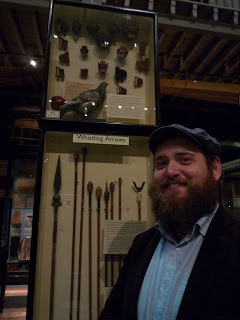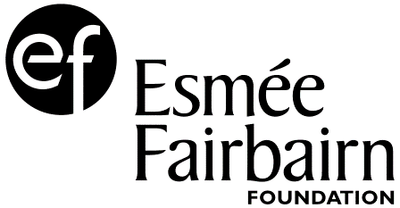The Pitt Rivers Museum's Embedded Composer in Residence
 Nathaniel Mann, the PRM Composer in Residence, standing in front of a display case containing some of the Museum's collection of pigeon whistles.Chopping tuned cleavers into wood blocks, fashioning a collection of dried fruits into buzzing instruments, and abseiling down pitch-black cliff faces to record the sounds of a guga hunting community. Nathaniel Robin Mann is a spectacularly creative and diverse musician and artist, and currently the Embedded composer in residence, supported by innovative organizations Sound and Music and Oxford Contemporary Music.
Nathaniel Mann, the PRM Composer in Residence, standing in front of a display case containing some of the Museum's collection of pigeon whistles.Chopping tuned cleavers into wood blocks, fashioning a collection of dried fruits into buzzing instruments, and abseiling down pitch-black cliff faces to record the sounds of a guga hunting community. Nathaniel Robin Mann is a spectacularly creative and diverse musician and artist, and currently the Embedded composer in residence, supported by innovative organizations Sound and Music and Oxford Contemporary Music.
Nathaniel has been drawing inspiration from the collections at the Pitt Rivers Museum throughout the last decade, and this has had a clear influence on his work as a composer and artist. He explains:
"I've recently realized that being embedded at the PRM has caused my compositional processes to become increasingly object led. I'm currently developing a range of projects, each of which involves the creation of new instruments and noise makers. Whether crafting choir-scaled shuddering voice disguisers, gamelan inspired tuned bronze meat cleavers, or bespoke pigeon whistles from recycled plastics, each project holds the object as central to the composition of new music."
A BBC Oxford interview with Nathaniel, broadcast in early August 2012 shortly after his appointment, can be heard below:
Across a period of eighteen months, Nathaniel's role is to fully embed himself in the collections and culture of the museum and to create work in response. He has already co-curated a late night event and produced a film documenting the evening during which a four hour playlist of Bayaka music was broadcast into the galleries, streamed live by webcam and watched back in the Central African Republic.
Nathaniel has also co-authored with the museum's ethnomusicologist, Dr Noel Lobley, an article on the work of Louis Sarno and his archive of Bayaka music.
Inspired by the museum's collection of voice disguisers from Nigeria, Nathaniel has grown his own gourds, fashioned them into instruments, which he sends to selected musicians for the creation of new work.
Similarly inspired by the museum's collection of pigeon whistles, Nathaniel has worked closely with an experienced pigeon fancier and has designed new whistles from recycled materials. He is composing new works for the pigeon whistles, which are small handcrafted gourds that are borne by flying pigeons. The whistles produce haunting drones that trace across the sky as the pigeons fly.
Nathaniel believes that sound and music have been, and will continue to be, a very significant part of the collections and culture at the Pitt Rivers Museum, and he explains that one of his main aims is:
"to draw attention to different cultures of listening. The museum offers an interesting challenge because it is not a performance space – nor a dedicated listening space – but the way people already engage with it means that when it is used as an environment for music and sound it offers unique listening experiences."
Nathaniel's Embedded Composer in Residence Blog can be followed here:
http://pittriversmann.blogspot.co.uk/
A wider range of Nathaniel's work as a composer, musician and artist can be explored below:
http://www.deadratorchestra.com/
www.factum-arte.com/eng/audio_works.asp
Nathaniel performing 'Canto de Hilar' ('song of sewing', collected by Alan Lomax in Spain in 1952).
Nathaniel performs '4C/P', one of his own compositions.
Stop-motion videoslip for the song 'The Owl and the Pussycat' by Nathaniel Mann, adapted from a poem by Edward Lear.


